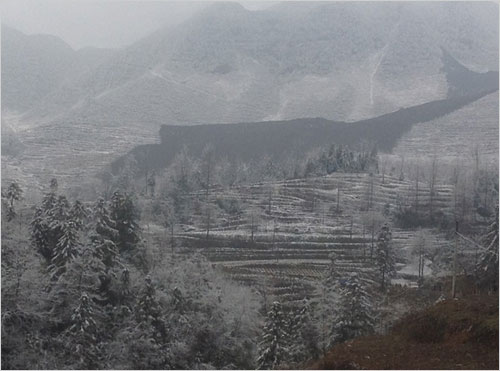14 January 2013
The Yunnan landslide and its relationship to earthquakes
Posted by Dave Petley
The final count of lives lost in the landslide in Yunnan Province in China last week is 46 people, of whom 17 were reported to be children. All of the bodies have been recovered – which given the size of the landslide is a remarkable achievement – but in China there is some controversy about the decision to cremate the remains without the permission of the relatives. It is not clear why this decision was taken, which does not accord with the religious traditions of the community affected.
Meanwhile, there is more information about the landslide in an article in the Global Times. This reports that the landslide was 120 meters long, 110 meters wide and 16 meters deep, which seems surprising given the images that first appeared in the aftermath of the landslide:
The landslide occurred in an area with coal mines, but the report rules out a link between the failure and these activities, instead drawing attention to the effects of both bad weather and the legacy of the M=5.6 and M=5.3 Yiliang County earthquakes on 7th September 2012. The link with the earthquakes not unreasonable at first inspection, and once again emphasizes the importance of the post-earthquake legacy of landslides, but the timing seems quite strange to me.
Finally, China Today is reporting that the 629 inhabitants of Gaopo Village will now be relocated. Even before the earthquake the area appears to have been under threat from landslides – the China Today article notes that there is a sign in the undamaged school that reads:
“Try to run and avoid the area if a landslide occurs,” reads a faded safety message printed on an outdoor blackboard at the Gaopo Middle School.
Of course knowing where to run is critical – trying to outrun a fast-moving landslide is unlikely to be successful. In general, instructing people to run away is not on the ideal list of landslide risk reduction approaches.



 Dave Petley is the Vice-Chancellor of the University of Hull in the United Kingdom. His blog provides commentary and analysis of landslide events occurring worldwide, including the landslides themselves, latest research, and conferences and meetings.
Dave Petley is the Vice-Chancellor of the University of Hull in the United Kingdom. His blog provides commentary and analysis of landslide events occurring worldwide, including the landslides themselves, latest research, and conferences and meetings.